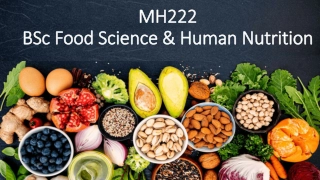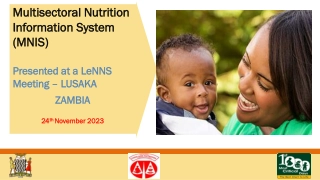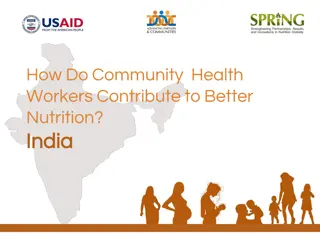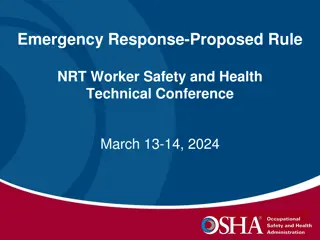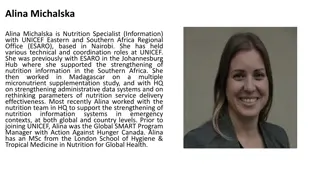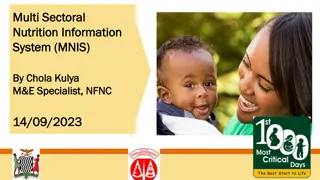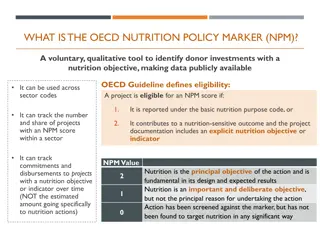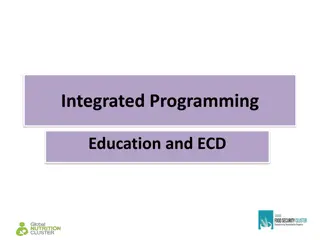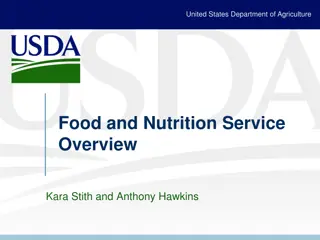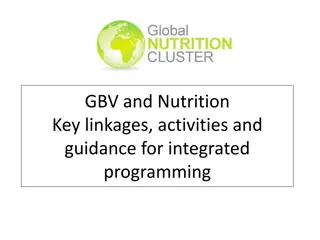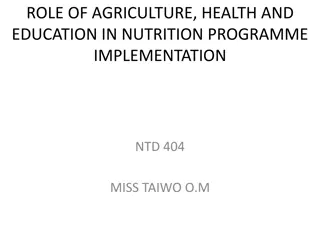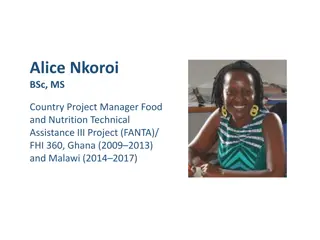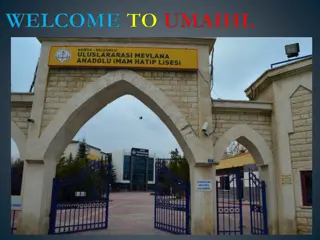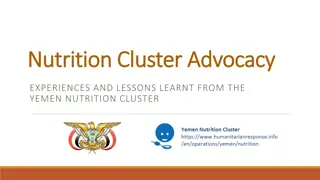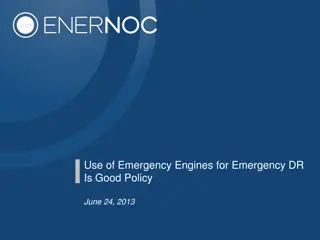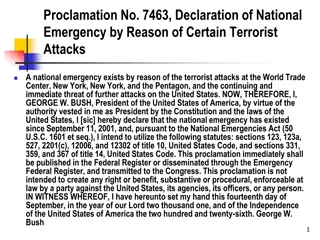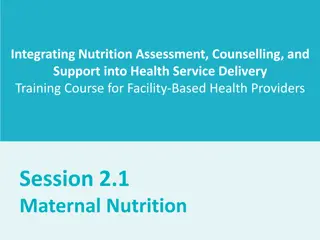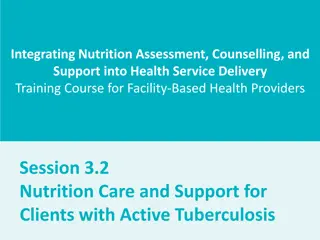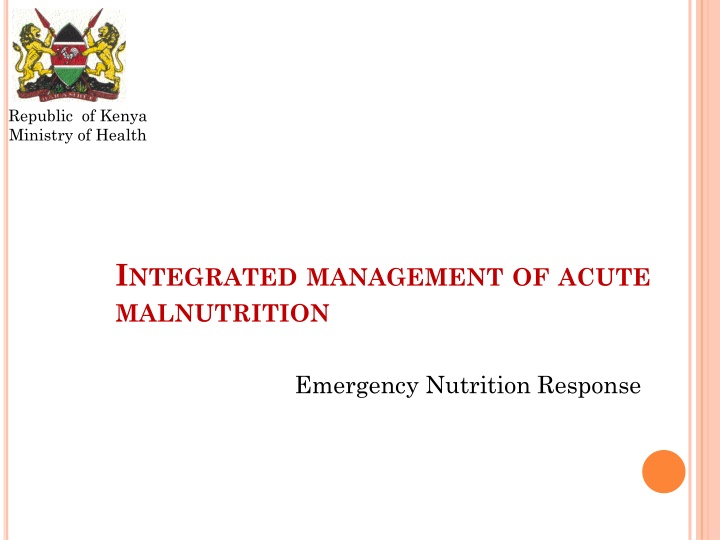
Managing Nutrition Emergencies in Kenya: Response and Preparedness
Learn about the integrated management of acute malnutrition emergency response by the Republic of Kenya Ministry of Health. Explore the overall and learning objectives, contents, and insights into vulnerable groups and humanitarian situations in emergencies.
Uploaded on | 0 Views
Download Presentation

Please find below an Image/Link to download the presentation.
The content on the website is provided AS IS for your information and personal use only. It may not be sold, licensed, or shared on other websites without obtaining consent from the author. If you encounter any issues during the download, it is possible that the publisher has removed the file from their server.
You are allowed to download the files provided on this website for personal or commercial use, subject to the condition that they are used lawfully. All files are the property of their respective owners.
The content on the website is provided AS IS for your information and personal use only. It may not be sold, licensed, or shared on other websites without obtaining consent from the author.
E N D
Presentation Transcript
Republic of Kenya Ministry of Health INTEGRATED MANAGEMENT OF ACUTE MALNUTRITION Emergency Nutrition Response
ACKNOWLEDGMENT MINISTRY OF PUBLIC HEALTH MINISTRY OF MEDICAL SERVICES
OVERALL OBJECTIVE To prepare health workers for prompt and effective response to Nutrition Emergencies
LEARNING OBJECTIVES By the end of this session, participants should be able to: Understand what causes nutrition emergencies Identify which groups are most nutritionally vulnerable in an emergency Be aware of the different types of emergencies Identify steps in Emergency Response Be aware of the range of food related emergency nutrition responses and when they are appropriate Identify requirements for emergency Nutrition Intervention Understand the coordination mechanism in emergency response
CONTENTS Overview Nutrition Emergency Response preparedness and response actions Actions for Nutrition Emergency Response Implementing Emergency Response Nutrition Interventions Supply Chain and logistics in Emergencies Monitoring Linking Nutrition Programmes and Other Interventions
EMERGENCYAND HUMANITARIAN SITUATION Emergency: an extreme disruption that causes widespread human, material or environmental losses that exceed the ability of the affected society to cope using only its own resources Humanitarian Situation: circumstance where humanitarian needs are sufficiently large and complex to require significant external assistance and resource requiring multi-sectoral response Kenya Emergency is characterized by hazards that are Rapid Onset and Slow onset Food and nutrition emergencies arises due to depleted food supplies leading to acute malnutrition Emergency food and nutrition interventions protect access of affected populations to adequate nutrition OVERVIEW
VULNERABLE GROUPS IN EMERGENCIES The population groups most nutritionally vulnerable in emergencies can be categorised as follows; OVERVIEW Physiological vulnerability : young children, pregnant and lactating women, older people, the disabled and people living with chronic illness such as HIV and AIDS)
VULNERABLE GROUPS IN EMERGENCIES The population groups most nutritionally vulnerable in emergencies can be categorised as follows: OVERVIEW Geographical vulnerability (e.g. people living in drought or flood-prone areas or in areas of conflict) Political vulnerability (e.g. oppressed populations) Internal displacement and refugee status (e.g. those who have fled with few resources)
SITUATIONOF KENYA Humanitarian health and nutrition actors include: National Government frameworks for resilience programming institutionalised (Ending Drought Emergencies 2013-2017) OVERVIEW UN agencies (WHO, WFP, UNICEF, UNHCR, OCHA) which work with the Red Cross, NGOs, CBOs, religious groups and co-operations. (See handout 6a )
CAUSESOF NUTRITION EMERGENCIES Rapid onset: floods in , conflict displacement due to insecurity, inter-communal violence and terrorist attacks, post-election violence, disease epidemics (cholera, polio, measles) OVERVIEW Slow onset: drought, flood, refugee influx that are seasonal/cyclical/chronic (e.g. combination of cyclic drought-induced crop failure, 2011 drought in Kenya and the Horn of Africa , refugee influx in Daadab and Kakuma)
NUTRITION EMERGENCY PREPAREDNESSAND RESPONSE ACTIONS Preparedness Mobilizing Resourses 1. 2.
EMERGENCY PREPAREDNESS PREPAREDNESS Aims to build capacities needed to efficiently manage all types of emergencies o Contingency planning identifies and plans for emergency situations and is prepared annually at national and county level o Contingency Plan elaborates the preparedness and response actions for coordinated response to crisis and implemented only in the event of an emergency. o Continuously reviewed o
EMERGENCY PREPAREDNESS MOBILIZING RESOURCES Understanding of Humanitarian and National Government appeals and funding mechanisms a) b) Prioritization focused on most urgent needs, and be transparency c)Response plans that address all types of resource mobilization finance, people, supplies
ACTIONSFORNUTRITION EMERGENCYRESPONSE 7 ACTIONS
ACTION 1: COORDINATION ACTION FOR RESPONSE Key focal points for coordinating response include: o Ministry of Interior and Coordination of National Government focuses on Disaster and Emergency Coordination (NDOC), I. National Drought Management Authority II. Crisis Reponse Center III. Kenya National Nutrition Action Plan (2012- 2017) defines nutrition objectives to be addressed o Nutrition Technical Forum (NTF) is responsible for technical coordinating structure and technical capacity o
ACTION 2: Assessments and Monitoring ACTION FOR RESPONSE Gain an understanding of impact of emergency through the following information sources: 1. Nutrition surveillance (slow-onset/chronic emergencies) 2. Rapid nutrition assessments (rapid-onset emergencies) 3. Anthropometric nutrition surveys (slow- onset/chronic emergencies OR rapid-onset emergencies)
Nutrition Surveillance ACTION FOR RESPONSE Process of monitoring trends in the nutrition situation over time is of high importance Enables management of risks associated with impending crisis and reduces impact of shock Kenya Surveillance system include: Revised Early Warning System for Kenya Seasonal Assessments: Health facility monitoring from the DHIS 1. 2. 3.
Nutrition Surveillance ACTION FOR RESPONSE Objectives include: Advocacy Identification of appropriate response strategies Triggering a response Targeting Identification of malnourished children
Nutrition Surveillance Cycle ACTION FOR RESPONSE
Rapid Nutrition Assessments ACTION FOR RESPONSE To obtain a snapshot of the nutrition situation as quickly as possible Performed in situations of poor security and limited access Information not statistically valid but verify existence or threat of nutrition emergency Enables estimation of affected population and immediate needs
Rapid household level nutrition assessment ACTION FOR RESPONSE Conducted based on KIRA findings and within 6 weeks Provides required information not covered by KIRA assessment Objective is gather data quickly and give estimate of nutrition situation The exercise should not exceed four days
Rapid household level nutrition assessment - Objectives ACTION FOR RESPONSE To estimate the nutritional status of children aged 6-59 months and PLW using MUAC To establish factors contributing to the overall nutrition situation of the affected population To be informed on the infant and young child feeding practices in the affected population To make recommendations that prevents deterioration of the nutrition situation
Rapid household level nutrition assessment- Methodology ACTION FOR RESPONSE Purposive selection of locations based on identified need for additional information Quantitative data through MUAC measurement Qualitative date through Focus Group discussions, Key informant Interviews , Secondary data and anthropometric surveys
Action 3: PROMOTE, PROTECTAND SUPPORT MATERNAL INFANT NUTRITIONIN EMERGENCIES (MIYCN-E) AND YOUNG CHILD ACTION FOR RESPONSE To reduce high risk of under nutrition during emergencies for optimal growth and development of children Includes protecting rights of all pregnant women, lactating mothers , infants and young children
ACTION FOR RESPONSE Action 3: (MIYCN-E) POLICY GUIDELINES Ensure that mothers and their infant are not separated for continuation of optimal infant feeding Protect, promote and support exclusive breastfeeding and optimal complementary feeding (assess need for supplementary food rations) in all emergency efforts. Periodic nutrition monitoring and surveillance including rapid assessments fostered and facilitated.
ACTION FOR RESPONSE Action 3: (MIYCN-E) POLICY GUIDELINES Technical representation in humanitarian coordination forums and promotion of cross-sector engagement. Policy, guidelines and standards for IYCN-E meet Inter- Agency Standing Committee (IASC) and SPHERE standards, and that systems support adherence. Minimize the risk of artificial feeding through ensuring that all emergency efforts including donations comply with BMS regulation and control Act 2012.
ACTION FOR RESPONSE Action 3: (MIYCN-E) POLICY GUIDELINES Optimal IYCN practices according to MIYCN policy Monitor the following indicators: Timely initiation of breastfeeding Minimum dietary diversity Minimum meal frequency Violation of the BMS act a. b. c. d. Emergency preparedness (Adequate local capacity, advocacy and national legislation in place)
ACTION FOR RESPONSE Action 3: (MIYCN-E) POLICY GUIDELINES Protect, promote, and support optimal maternal infant and young child nutrition through: Caregiver and children have timely access to skilled feeding support Provide information to families on MIYCN Support to breastfeeding mothers Access to safe and adequate complementary feeding Advocacy to meet and protect nutritional needs of population and children Appropriate feeding for children with no prospect to be breasfed
Action 4: Mount Capacity at Facility and Community level ACTION FOR RESPONSE Availability of policies and guidelines for HiNi interventions Regular orientation and sensitization on policies and guidelines through retraining and mentoring of health workforce Kenya Red Cross Society is country s first line responder and deploys team of volunteers and emergency health personnel
Action 5: PROVIDEAPPROPRIATENUTRITIONAL PRODUCTS, ANDEQUIPMENTFORMANAGEMENTOF ACUTEMALNUTRITION ACTION FOR RESPONSE Stock piling and pre-positioning of supplies and equipment Availability of complete basic kits at Humanitarian hubs and awareness of where to get nutritional products Forecasting and nutrition supplies chain management
Action 6:CONTINUOUS SERVICE DELIVERYOF HIGH IMPACT NUTRITION INTERVENTIONS ACTION FOR RESPONSE Partners work through government leadership Remote management when access is not possible
ACTION FOR RESPONSE Action 7: STREAMLINED COMMUNICATIONS & ADVOCACY Use of available validated package of relevant nutrition messages for advocacy
IMPLEMENTING EMERGENCY NUTRITION RESPONSES
SCALING UPNUTRITIONEMERGNCY RESPONSE EMERGENCY RESPONSE Preparedness by promoting readiness and the ability to cope and respond to emergencies at all levels. Prevention of emergency situations to the extent possible. Mitigation: minimize the effects of the emergency. Inter sectoral collaboration : meet the needs of people affected by the emergency situation in a coordinated, efficient and timely manner.
GENERAL FEEDING PROGRAMME(GFD) EMERGENCY RESPONSE Food rations given to selected highly affected households delivered as a package of dry items Objective is to save lives, protect nutritional status of population and rehabilitate livelihoods GFD used to respond to food need based on livelihood, economic, nutritional and key vulnerable group targetting Rations must provide at least 2100 kcal per person per day.
GENERAL FEEDING PROGRAMME Provides food to the affected population as a whole. INTERVENTIONS General rations are usually provided as dry rations for people to cook in their homes. The local community's food habits, tastes and preferences must be taken into consideration when distributing general food rations.
BLANKET SUPPLEMENTARYFEEDING (BSFP) EMERGENCY RESPONSE Provide a food supplement to all members of an at-risk group (e.g. children, pregnant and lactating women) irrespective of nutritional status. Objective to prevent nutritional deterioration, related mortality and morbidity Implemented when : GAM is > 20% with aggravating factors I. Inaccessibility of target population II. Early stage of an acute crisis III.
BSFP- TARGET GROUPAND ENTRY EMERGENCY RESPONSE Children under 5 years: Height < 110 cm Pregnant and Lactating women with children < 6 months
BSFP- FOODRATIONSAND TREATMENT EMERGENCY RESPONSE Food rations: Timely Distribution, prepositioning of stocks Treatment: Vitamin A, deworming tablets, zinc, iron/folate tablets, micronutrient powders and immunizations Beneficiary Identification: registered and provided with serialized ration cards for ease in follow up, and to avoid double distributions Phased out when: there is anticipated decrease in acute malnutrition rates Target groups no longer vulnerable GFD is adequate I. II. III.
BSFP PROGRAMMESETUP EMERGENCY RESPONSE Human Resource requirements on site: Nurse, CHWs, Clerks, Guards, VHCs Sub county/county level: Team Leaders, an M&E officer, Logistician and Programme Coordinator. BSFP staff to beneficiaries ratio per site: 1000 beneficiaries per site OR 250 beneficiaries per team Supplies: Office spacce, equipment, materials BSFP Documentation: All data collected during BSFP feeds into the DHIS, and existing MOH tools should be used should be BSFP reporting
BSFP PROGRAMMESETUP EMERGENCY RESPONSE Supervision and Management Supervision is important to ensure effective implementation of response programs Managers are accountable for their decisions and for ensuring adequate security and compliance to the codes of conduct All staff must have a written job description with clear reporting lines and undergo periodic performance assessments Transport must be provided for supervisory personnel on a full time basis
BSFP PROGRAMMESETUP EMERGENCY RESPONSE Linkages with IMAM: Acute Malnutrition cases referred to IMAM programmes for treatment and follow up Supplementary Feeding : Can be take home (Dry rations) weekly or very two weeks OR onsite feeding (wet ration) everyday at a feeding center
METHODSOF SUPPLEMENTARY FOOD DISTRIBUTION Take-home / dry ration A regular (weekly or bi-weekly) distribution of food in dry form to be prepared at home. EMERGENCY RESPONSE On-site feeding / wet ration A daily distribution of cooked food at feeding center offered. Only considered for extreme situations as it is time consuming and also undermines the family's ability to take responsibility Generally, take-home or dry ration is the preferred option as it requires fewer resources and less hardship on the patients. It also may also create undesired population movements into centres There is no evidence that on-site SFPs are more effective. The number of meals provided varies, but, usually 2 - 3 meals each day.
BSFP PROGRAMMESETUP EMERGENCY RESPONSE Advantages Dry feeding Advantages Wet Feeding o It is easier to organize when resources are limited o Serves more children with lower risk of transmission of communicable diseases o Better coverage o Takes up less of mother s time o Easily accessible for a dispersed population o Prevents displacement cooking facilities (fuel, pots) are a major problem in the community Feeding population influx/displacement at reception/transit centers Food supply in the household is extremely limited prevents sharing of supplementary rations Good for orphans and/or unaccompanied children
SUPPLY CHAIN LOGISTICS IN EMERGENCIES
PROCUREMENT SUPPLY & LOGISTICS Ensures organizations involved in relief management have resources needed to meet identified needs Requires identifying the sources of those goods and services and the way in which they will be acquired
TRANSPORT SUPPLY & LOGISTICS A transport strategy must consider: The means of transport Actual possibilities of getting supplies from point A to B alternatives for the prompt, safe delivery of relief assistance a. b. c. Seasonal delivery problems such as floods and impassable roads, will adversely influence the transportation. o
STORAGE SUPPLY & LOGISTICS Purpose of storage is to protect the emergency supplies in an organized, systematic way until delivered to their ultimate recipients o It must also take into account reserve supplies, or stockpiles, for future or unforeseen needs. Short-term food aid transit storage dictates the following major requirements: a. security from theft b. protection of stocks from enviromental factors like rain, and pests, especially rodents and birds c. easy intake and dispatch of goods, including good access to the store o
STORAGE SUPPLY & LOGISTICS d. good in-store handling arrangements and access to all stocks for inspection, physical stock-taking and insect pest control where necessary e. easy maintenance of the store structure f. Satisfactory working conditions for staff and laborers. g. Security is listed as the first requirement for consideration in storage because it is particularly important in transit stores, which are frequently opened, often located in towns, and commonly contains fast-moving foodstuffs.

